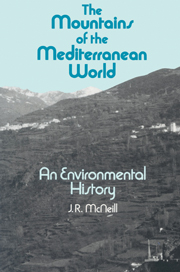Book contents
- Frontmatter
- Contents
- List of Illustrations and Tables
- Preface
- Note on Transliteration
- List of Abbreviations
- 1 The Argument: Ecology, Economy, Shells, and Skeletons
- 2 Mediterranean Mountain Environments
- 3 The Deep History of Mediterranean Landscapes
- 4 Material Life in the Mountain Environment, 1700–1900
- 5 Population, Settlement, and Landscapes
- 6 Political Economy and Mountain Landscapes
- 7 The Changing Landscape since 1800
- 8 Conclusion
- Bibliography
- Index
2 - Mediterranean Mountain Environments
Published online by Cambridge University Press: 29 September 2009
- Frontmatter
- Contents
- List of Illustrations and Tables
- Preface
- Note on Transliteration
- List of Abbreviations
- 1 The Argument: Ecology, Economy, Shells, and Skeletons
- 2 Mediterranean Mountain Environments
- 3 The Deep History of Mediterranean Landscapes
- 4 Material Life in the Mountain Environment, 1700–1900
- 5 Population, Settlement, and Landscapes
- 6 Political Economy and Mountain Landscapes
- 7 The Changing Landscape since 1800
- 8 Conclusion
- Bibliography
- Index
Summary
There is no species of animals on earth, nor birds on the wing, who are not part of a community, just as you are.
Koran, 6.38The casual observer finds in the Mediterranean world a certain unity. In ancient times the Mediterranean exhibited considerable cultural unity, many traces of which still survive. Belief in the evil eye exists on all shores of the Mediterranean. The same gesture of the wrist is used in the Casbah in Algiers and Trastevere in Rome to mean “I don't know.” At various times the Mediterranean has exhibited a certain economic unity, its phases of expansion and contraction felt throughout. Whereas cultural and economic unity may have come and gone, ecological unity has not. Ecologists do not agree as to what constitutes an ecosystem – some prefer the scale of a fishpond while others feel Amazonia qualifies – but none fail to see the Mediterranean as an ecological unit. They may call it a single ecosystem or a series of parallel ecosystems, but they all recognize its distinctiveness just as easily as the casual observer feels it.
The Mediterranean Zone
The Mediterranean is not so much the sea between the lands, as its name asserts, but the sea among the mountains. Except for the long stretch of lowland desert between Tunisia and Sinai, one is almost never out of sight of mountains if within sight of the Mediterranean coast.
- Type
- Chapter
- Information
- The Mountains of the Mediterranean World , pp. 12 - 67Publisher: Cambridge University PressPrint publication year: 1992



